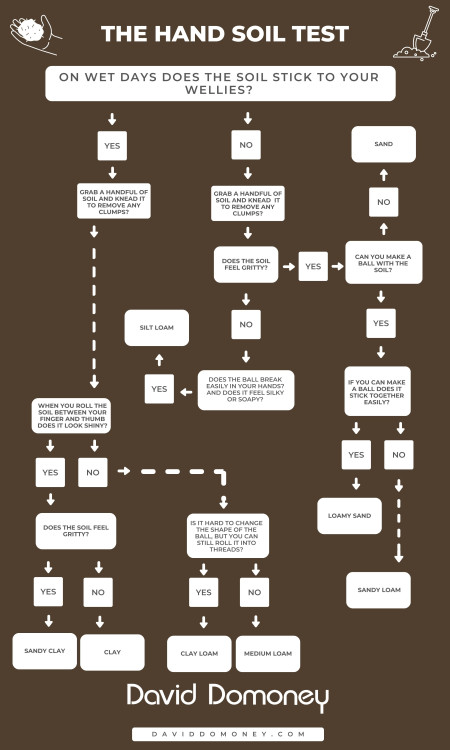Taking the time to find out what type of soil you have in your garden is critical to your success as a gardener. Like a chef knowing the difference between gas, electric, ceramic, or induction hobs, and the ways these devices cook food; when you understand your soil, you are on your way to having a stunning garden.
What tests do I need to do?
There are three manual tests you can do that will help you. First up is the hand test. We do this test straightaway as it involved less digging.
The Hand Test
Follow the diagram and answer the yes or no questions to find out which type of soil you have. You can also download a copy here.
The second of these is the pit test. And as it sounds the pit test requires you to dig a pit.
The Pit Test
Make sure that your soil is moist when you do this as the ground tends to easier to be work in these conditions. Your pit needs to be 60cm x 60cm x 60cm.
If the topsoil is dark, but the subsurface (around 15cm below the surface) is grey to white in colour then the soil is Chalky. But, if the subsurface pan is present – a solid lay of earth that feels like baked clay or there are flecks of blue or rusty coloured soil, then you have poorly-drained soil.
Thirdly there is the walkover test.

The Walkover Test
To complete this test, you walk over your garden soil. You do this on a day when the soil is moist, and your plants appear to be thriving. As you walk across the surface, do you notice a high number of stones, both large and small? If you do then, you have stony soil. If this isn’t the case, and the soil seems spongy, rich in plant remains, and dark brown or grey in colour then you have peat soil.
Now there is still some work to do, and this is where it can get a little confusing. But stick with me. If you answered Yes to either of the previous questions or No, there are four additional questions to ask yourself which will further help you identify the soil.
1) Is the surface covered in moss and/or a greenish slime? If Yes, then you have poorly draining soil.
2) If the weeds your see include dock, thistles, and daisies, and you have rhododendrons or camellias in the garden with good green leaves, then you have Acid Soil.
3) If you have a lot of clover, and plants like rhododendron and camellia are yellow, you have alkaline soil.
4) And if your soil has a lot of stinging nettles, chickweed, or groundsel, then you have fertile soil.

How to test the pH levels of your soil
As I’ve just mentioned, by doing a visual check on the plant life that flourishes in the garden, you may have an indication of whether your soil is acid or alkaline. However, to be 100% sure, I would recommend that you carry out a pH test.
This sounds more daunting than it is. You can pick up devices that you push into your soil to check the levels, or you can do your own little science experiments using pH paper. With this information in hand, you can be sure about the plants that are best suited to your garden.



Leave A Comment